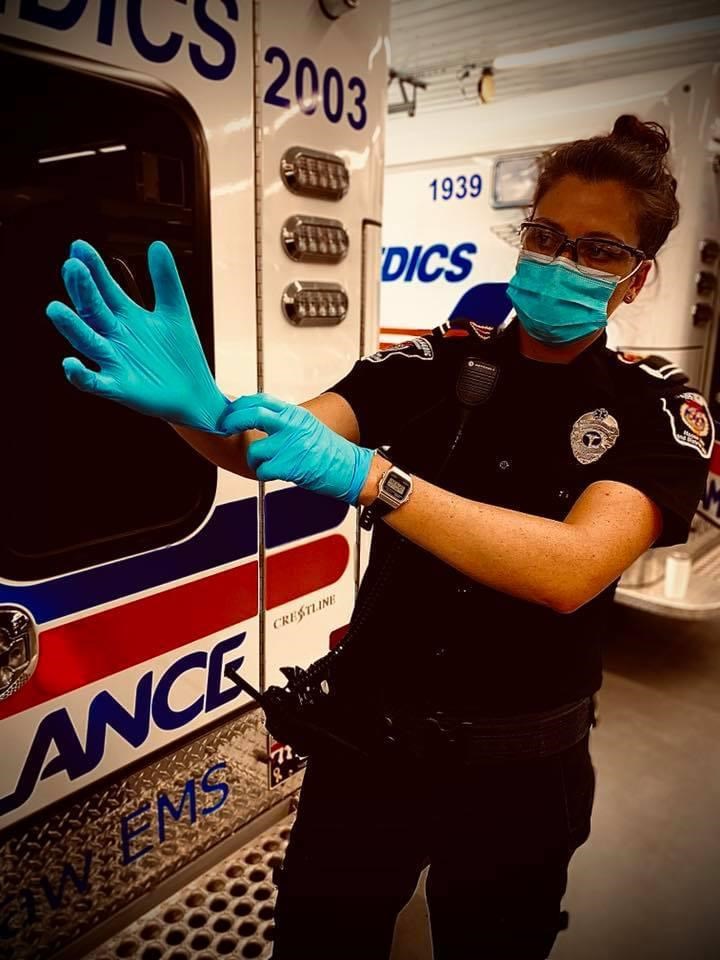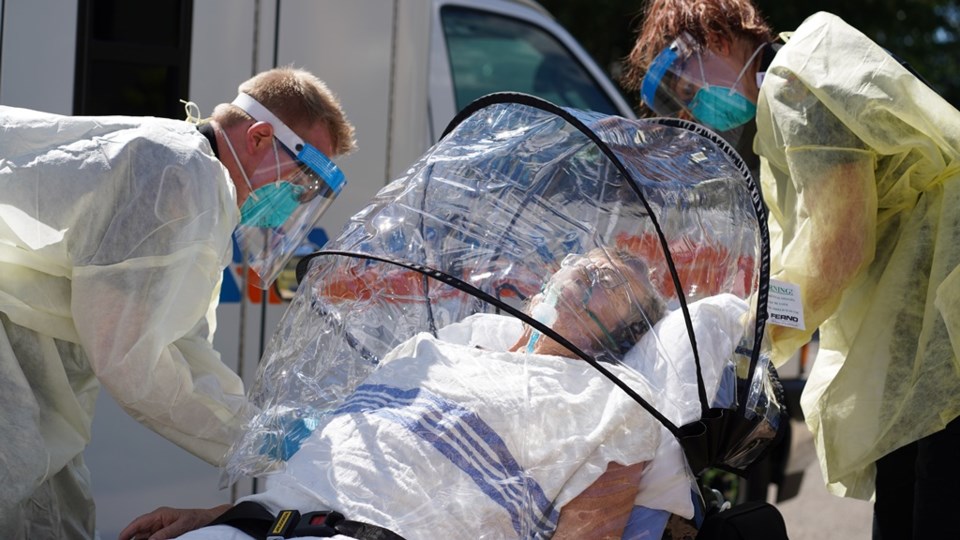With 2021 well underway, plenty of local organizations are looking back at the past year and all of its challenges and advancements, as a way to find hope in the future ahead — including the Moose Jaw & District EMS.
The Moose Jaw Express / Moose Jaw Today sat down with EMS Chief Kyle Sereda to talk about the ups and downs that paramedics faced during 2020, and what that means for the city’s first responders.
“Personally, they’re reflecting and looking more at how we are making a difference. We always believed we were doing a great job,” said Sereda. “But this is a global health emergency and we’re health professionals, working out of hospital environments, so that’s given them a sense of pride. They were valued before, but some of the public highlights on what we’re doing and how we’re doing it, that’s made them proud.”
In a year overwhelmed with a global pandemic, Sereda said that paramedics felt both the strain and support directed their way even more acutely than usual. As first responders — frontline workers, as the 2020 lingo would say — paramedics have faced a long 12 months of changes that have challenged them daily.
Between adding layers of essential personal protective equipment (PPE) to their preparation routine and seeing a reduction in viable social outlets, local paramedics have struggled alongside the community in many ways.
But, as Sereda also noted, the changes that came about during 2020 have also brought along a beacon of positivity: renewed interest in expanding non-acute services from paramedics, a pinpointed focus on mental health and the prompting of important research that could change EMS operations forever.
Adjusting to new guidelines as frontline workers
When people try to imagine the challenges that paramedics faced in 2020, the sudden inclusion of new and extensive protective guidelines is likely the first image that comes to mind.
“Especially in the first six months, there were days when things would change within a day. We’d come in in the morning, do reports, find out what’s new and what we had to know, and by the end of the day, before you even come to work the next day, they’re different,” said Sereda. “It's extremely frustrating, and paramedics wore that as best they could.”
Paramedics are now wearing extra PPE during all calls, in comparison to just carrying it in ambulances, and using new equipment like plastic patient hoods during transport to reduce transmission risks.
Increased sanitation is also taking place, with Moose Jaw EMS utilizing fog machines to more thoroughly sanitize surfaces in ambulances after every call and ultraviolet light to disinfect shared equipment like radios and keys between shifts.
“We already spent a lot of time disinfecting patient compartments in the ambulance as well as the front cabs, but now, because the virus is transmitted by touch and aerosolized molecules, there isn’t anything inside that ambulance that isn’t disinfected on a more regular basis,” said Sereda.
Sereda felt that paramedics have adjusted incredibly well to the increased workload, especially as the pandemic continues.
“Part of our training is adapting to adversity, but they’ve really had to adapt right now. This is a long-term challenge, this isn’t just a winter storm that will in a week get better,” said Sereda. “This is coming up on a year that our world has been different, and they’ve done really well. I have to commend them.”
The positive side to the additional safety practices, said Sereda, is that they must be backed by confirmed research to be valid — meaning there’s been an influx of research done on topics that will likely benefit EMS operations in the long run.
“We probably should have been doing them long before, but the research wasn’t there, it wasn’t prioritized,” said Sereda. “But we’ve taken on these things, and we'll likely continue with them because they make the provider safer, they make the patient safer.”
Shifting the scope of paramedic services
During 2020, paramedics found themselves actually increasing their duties in terms of providing care within the community.
With hospitals exercising more caution about incoming patients and, in some cases, operating with limited capacity, Sereda said that 2020 saw paramedics performing more non-acute services on-site during calls, in addition to emergency services.
This means paramedics have been providing non-emergent care for patients where transport isn’t necessary — for example, addressing a catheter or feeding tube problem, treating infections before it gets out of hand, or responding to mental health and addiction calls.
Paramedics have also been delivering care to residents in long-term care homes, especially ones who have positive COVID-19 cases, to help reduce the risks of virus transmission that come with transport.
Paramedic care has been leaning in this direction for a while, said Sereda, and the pandemic has really highlighted the value and streamlined pending projects due to a rise in need.
“There’s a tremendous value in [these programs],” said Sereda. “We’re complimenting in the best way we can, and these are just really good things that are patient-centred that we’re happy to see the SHA expedite.”
In addition to avoiding unnecessary stress over transporting patients, these kinds of on-site services have also shown to decrease health risks for all parties involved — patients, EMS providers and hospital or clinic staff.
“We see these programs continuing on, because they make sense and they have an actual impact. We’re seeing patients, responding to patients and not transporting them, which has a cascade effect down the line of healthcare,” said Sereda. “We’re not taking up a bed in the ER, not taking a bed in a ward, because we were able to catch an infection or do a treatment that didn’t get out of hand or wasn’t neglected earlier on.”
Unseen challenges for outside of the depot
While the on-shift changes have certainly affected paramedics, Sereda explained that off-shift regulations have also made a big impact on personnel and their mental health.
Being frontline workers, paramedics have been even more isolated than other members of the community, as they have been following strict no-contact orders in their social lives in order to protect the entire depot.
“One paramedic could infect their crew, could infect the entire organization [and] that would have such detrimental effects in the city, because now who will provide our services?” said Sereda. “We’re no different from others working frontline too. The risks are higher and you have to be more diligent, and they have taken that on here. They’re pretty serious about what they do, and we’re happy to see that.”
Mental health has been a huge topic of conversation throughout 2020. Just like anyone else, paramedics are struggling with the isolating circumstances of the pandemic in addition to the added stress of their profession.
With most social activities currently shut down, Sereda noted that many frontline workers have been left with little in the way of stress relief outside of their shifts.
“They are being asked to do more, to be more careful with all this PPE, to take more precautions and be more vigilant [and] the longer this goes on, the more of a challenge it has become because all of the outlets they have to mitigate their health and wellness, like vacation and going out or seeing friends, socializing, they’ve been taken away,” said Sereda. “A lot of people are, ironically, finding that coming to work is their only social outlet, which isn’t always good either.”
Personnel have also been taking less vacation time, said Sereda, as they’re unable to go anywhere, and sick time is also on the decline as staff are out and about less often.
“It’s been tough, and we’ve seen some of the effects on individuals who are trying,” said Sereda. “People need those breaks. They really need to get away from the stresses of this job. These guys and girls have a tough job, and they do need that time off [so] it's a challenge we’re finding ways to overcome.”
One thing Sereda is proud to say this year is that Moose Jaw EMS has not had any paramedics yet test positive for COVID-19, proving that the safety measures they are working so hard to follow are making a difference.
“I attribute that to the seriousness of what they’re doing and how they’re taking the steps to not get sick or risk bringing it into the workplace,” said Sereda. “We’re pretty proud of that, out of 30 paramedics here, nobody’s tested positive and they’ve gone to every environment possible.”
 Moose Jaw EMS Chief Kyle Sereda said the guidelines around PPE and sanitation could stick around for good, as paramedics consider the benefits.(supplied / Moose Jaw & District EMS)
Moose Jaw EMS Chief Kyle Sereda said the guidelines around PPE and sanitation could stick around for good, as paramedics consider the benefits.(supplied / Moose Jaw & District EMS)Paramedics in the public eye
Media and community focus has been trained on frontline workers a lot in the past year, which Sereda felt both bolstered morale and also caused some strains.
Something that he saw challenging paramedics was stress from public expectation, especially from individuals upset about the extra time it takes paramedics to put on PPE when responding to a call.
“We always try to educate the public that there is no emergency in a pandemic. Our paramedics need to protect themselves first, and they’ve always been trained that you can’t help anybody if you don’t help yourself first,” said Sereda. “I understand people don’t always look at it that way, because they’re concerned about their loved ones, and we are too, and often after we explain it, they tend to understand.”
But the majority of attention directed toward paramedics in 2020 has been positive, he continued, as the general public took more of an interest in what paramedics are doing as healthcare professionals.
“I do think there’s more awareness of how paramedics are being utilized. We’re giving vaccines, we’re screening, we’re helping do the things that don’t need transport,” said Sereda. “There are more questions about what we’re doing and why, and it’s good that we can educate people about those things.”
The continued expression of support from the public has also been helpful for the mental well-being of paramedics, said Sereda.
“The public has been helpful too, with the support that we’ve gotten from them. Early on, with a lot of resources like PPE, hand sanitizer and masks,” said Sereda. “All the gratitude and thanks we’ve received for paramedics and what we’re doing, that has been nice to see.”
There is one thing Sereda admitted that has been sorely missed at the Moose Jaw EMS headquarters this past year.
“If there’s anything we’ve missed with all of this, it's that we used to often get accolades from patients or families who’d bring us cookies or donuts or coffee and stuff, and we’re not able to accept them right now. It always made them feel good [and] we don’t often turn down a plate of cookies. You put a plate full of cookies in a room full of paramedics and we’ll give that plate back before you leave the parking lot,” he laughed.
Overall, Sereda feels that the difficulties of 2020 have ushered in a new perspective for paramedics to grow from as 2021 commences. The crew at Moose Jaw EMS are definitely looking ahead to the future, especially as vaccination continues in the province, as they continue to provide the best care possible to the community.
“There’s been a lot of good and certainly some challenges, but the team’s pretty confident and optimistic that there is some light at the end of the tunnel,” said Sereda. “I think the biggest challenge is behind us, I really do [and] we’re smarter now than we were a year ago.”




